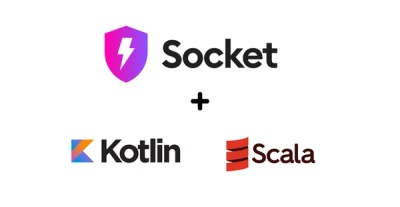
Product
Introducing Scala and Kotlin Support in Socket
Socket now supports Scala and Kotlin, bringing AI-powered threat detection to JVM projects with easy manifest generation and fast, accurate scans.
A queue with a unique use case.
I created this queue data structure because of the unique use case I ran into. I needed to open files in an asynchronous way, to maximize efficiency. But I needed to read from them in order, including subdirectories. This queue helped me do that, although for now I can't think of other use cases for this.
I've also tried to think of a way to simplify this and possibly break it down into 2 type of queues. But since both workers depend on each other and share the same concurrency, I'm starting to think this is what the simplified solution is. :/
Creates a queue with the given workers and concurrency. Jobs will be executed asynchronously with no more than concurrency running at once. worker1 will be alled the arguments which Queue2#push() was called with plus a callback function that should be called with either an error or results when the task finishes.
function worker1(a, b, c, callback) {
someAsyncOp(a, b, c, callback);
}
The worker1 function is also called with a context which contains a method named inject for placing additional tasks in place, in the same position, of the current running task. The context also includes an injected key which will be true if the current task was added using the inject function.
function worker1(a, b, c, callback) {
this.inject([
[1, 2, 3],
[2, 3, 4],
[3, 4, 5]
]);
}
The callback should not be called when inject is used. Since the tasks injected are supposed to replace the current one.
Pushes a task onto the queue. If the last argument is a function and it corresponds with the position of the callback from the first worker, then it will be called once there is an error with the task, or the task finishes.
For example:
const q = new Queue2((a, callback) => {
// a === 1
callback(null);
}, worker2);
q.push(1, (err) => {
if (err) throw err;
// will be called once this finishes
});
q.push(1);
Number of active tasks that are running.
Kills the queue.
ErrorEmitted when there is an error processing a task and a callback isn't given to the push method.
Queue is full.
Queue is empty, with tasks still running.
Queue is empty and tasks have finished.
npm install queue2
Tests are written with mocha
npm test
FAQs
A unordered queue and ordered queue working together.
The npm package queue2 receives a total of 82 weekly downloads. As such, queue2 popularity was classified as not popular.
We found that queue2 demonstrated a not healthy version release cadence and project activity because the last version was released a year ago. It has 1 open source maintainer collaborating on the project.
Did you know?

Socket for GitHub automatically highlights issues in each pull request and monitors the health of all your open source dependencies. Discover the contents of your packages and block harmful activity before you install or update your dependencies.

Product
Socket now supports Scala and Kotlin, bringing AI-powered threat detection to JVM projects with easy manifest generation and fast, accurate scans.

Application Security
/Security News
Socket CEO Feross Aboukhadijeh and a16z partner Joel de la Garza discuss vibe coding, AI-driven software development, and how the rise of LLMs, despite their risks, still points toward a more secure and innovative future.

Research
/Security News
Threat actors hijacked Toptal’s GitHub org, publishing npm packages with malicious payloads that steal tokens and attempt to wipe victim systems.